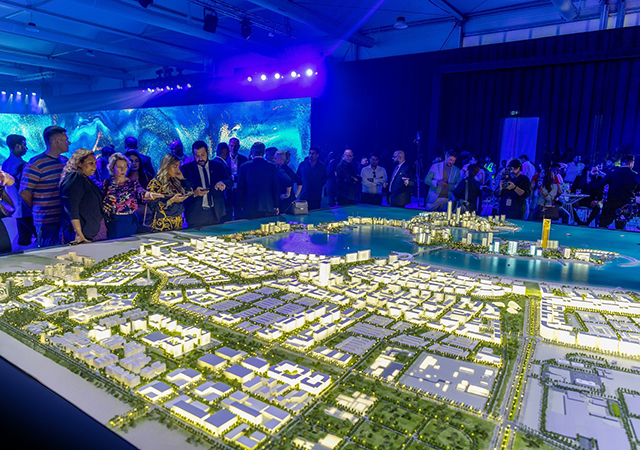
 The Geberit BIM Plug-in offers a reliable, integrated solution that meets all the needs for a correct planning process, enabling straightforward sanitary planning.
The Geberit BIM Plug-in offers a reliable, integrated solution that meets all the needs for a correct planning process, enabling straightforward sanitary planning.
Digital planning and construction using the BIM (building information modelling) method has brought about fundamental changes in the construction industry. The holistic and model-based approach means that planning and construction processes can also be optimised and accelerated within the sanitary industry.
Geberit’s aim is to create simple and innovative solutions that offer sanitary engineers, architects and contractors added safety and greater cost-effectiveness. And with the new Geberit BIM Plug-in for Autodesk Revit, another important step has been taken in the right direction.
With a single plug-in for all tools, it’s never been so easy: The new Geberit BIM Plug-in for Autodesk Revit is an integrated tool that brings together all previous Geberit planning and calculation tools for Autodesk Revit in a single integrated application.
Geberit relies on highly simplified, parametric geometries with all the metadata that is relevant for planning in the background. This avoids overloading CAD systems from the outset and allows for efficient planning. Despite their highly simplified geometry, Geberit BIM objects meet the requirements of all planning and construction phases, right through to facility management.
 |
|
The Geberit BIM Plug-in offers a reliable, integrated solution that meets all the needs for a correct planning process, enabling straightforward sanitary planning. |
Finding up-to-date, complete and valid BIM content that is easy to manage is often a challenge in itself. The Geberit BIM Plug-in offers a reliable, integrated solution that meets all the needs for a straightforward and correct planning process enabling straightforward sanitary planning.
The new Geberit BIM plug-in is current and with the direct connection to the Geberit product information management (PIM) system, it ensures that the user only uploads tested and approved BIM objects. This eliminates the risk for planning errors caused by faulty or invalid BIM content.
How does it work? Very simply!
- Download the plug-in on the Geberit website: www.geberit-global.com/BIM; and
- Log in and install the plug-in.
There are four modules:
- Catalogue module: Provides quick and direct access to all Geberit BIM content. The Catalogue module includes a whole host of product groups spanning piping systems, installation systems, and now also ceramic products and bathroom furniture;
- Installation systems module: Offers a simple design of the installation systems with a complete material list. The module saves the need for parallel planning in another software to facilitate the planning process;
- Wizard module: Features practical functions for planning supply networks and pipe runs that facilitate prefabrication significantly by enabling accelerated and cost-optimised prefabrication planning processes. What’s more, it is now possible to search for products using Geberit article numbers; and
- Pluvia module: Calculating the hydraulic certification and dimensioning for roof drainage with Geberit Pluvia Complex static data becomes simple parametric models - directly in Autodesk Revit.
Planning is, therefore, done easily from the shell to the finished bathroom. The entire Geberit product universe, complete with all its calculation options, is now available in a single central tool – for integrated planning from the piping system through to the final bathroom fittings.
Everything that belongs together now stays together in the planning phase. It doesn’t matter whether the chosen bathroom design determines the installations required or whether the bathroom is equipped based on MEP specifications, any planning errors or changes are indicated at an early stage.
Parametric BIM content for Geberit installation systems offers a wide range of added value for planners. It takes a whole host of factors into account, including the height adjustability, angle adjustment and depth of the connection bend, as well as the adjustable installation depth of the installation element.
The models in the ceramic and furniture ranges are depicted in both the right shape and the right colour. To take an example, the Geberit Revit models in the ceramic and bathroom furniture series are also helpful for architects, as native Revit models can also be read into the new ArchiCAD 24 version. When it comes to functionality and range, the Geberit BIM Plug-in is a comprehensive planning and calculation tool that is available to users free of charge. The integration of ceramic products and bathroom furniture facilitates a holistic approach from architecture to MEP planning and interior design.
Work is so much easier with the Geberit BIM Plug-in, which steps in at just the right moment to do some of the thinking for you. Less time is wasted searching, and there are significantly fewer sources of error. Now it is a lot easier to find products by partially entering the article number. Just like the Geberit online catalogue, the Geberit BIM Plug-in offers a search function by article number. All you have to do is enter at least three digits and the tool searches the database for possible hits. Of course, the more digits you enter, the faster you will find the product you are looking for.
The Installation Systems module allows you to design and calculate pre-wall installations automatically without the need for further tools. The results include not only construction drawings, but also exact cutting and material lists.
The Pluvia module facilitates optimal hydraulic dimensioning of Geberit Pluvia roof drainages. The current regulations and standards are stored in the plug-in, and there is no need to jump back and forth between different software solutions.
The Autodesk Revit system pipes do not have any article numbers. With the help of the numbering wizard, the Geberit article numbers can be written directly on the system pipes. This not only saves time spent looking things up, but also prevents the errors associated with manual entries. Even for ongoing or older projects, a model-based tender can be generated very easily.
Sanitary planning with the Geberit BIM Plug-in offers a whole host of advantages for efficient, model-based prefabrication. Well-thought-out functions facilitate efficient, model-based prefabrication with the greatest possible freedom when it comes to the arrangement of the components to be prefabricated. In this way, the Geberit BIM Plug-in enables cost-optimised MEP planning and increases economic efficiency in the process.
When modelling the BIM objects, wastewater prefabrication requirements have already been considered. As a result, all the fittings are equipped with the article-specific Z-dimensions. This means that the pipelines to be connected are automatically shortened to the correct length for the prefabrication.
The numbering wizard can be used to sequence and number components and individual sections of a complete supply network. This allows the operator to retain full control over the number assignment, thanks to freely selectable logic. As a result, it is possible to precisely define in the model which components of the supply network are to be prefabricated - an essential prerequisite for efficient prefabrication. A list of pipelines and fittings, sorted by item number, can be exported from Autodesk Revit. This means that precut pipe sections can be easily labelled to ensure quick assignment and identification during the mounting process, making it is much easier to bring together prefabricated, numbered segments or pipe sections on the building site.
Planning with the Geberit BIM Plug-in significantly increases planning convenience, as the Geberit BIM objects are available in 35 national languages and 41 local assortments and are constantly being updated. To make all of this possible, Geberit invests a great deal in the process of creating and updating the BIM content and in the continuous expansion of the Geberit BIM Plug-in.
Ultimately, everyone involved in the project - from architects and sanitary engineers to plumbers, building owners and end users - benefit from the quality of the database. The ability to select a specific language and region allows the Geberit BIM Plug-in to be used worldwide. What’s more, local product catalogues also ensure that only products that are available locally are used.
Public projects are often tendered on a manufacturer-neutral basis. This is why Geberit BIM content can be changed to generic designations with a simple click in the built-in parameters. Once the tender is over, this can be reset so that the time-consuming replacement of objects in the BIM model is no longer necessary.
The new BIM objects for Geberit ceramics and bathroom furniture facilitate close cooperation between architects and MEP planners, as architects can get the bathroom fully equipped with furniture and sanitary appliances before the MEP planning even takes place. This gives MEP planners a much better impression of how architects envisage the bathroom.













(5).jpg)








.jpg)



















































